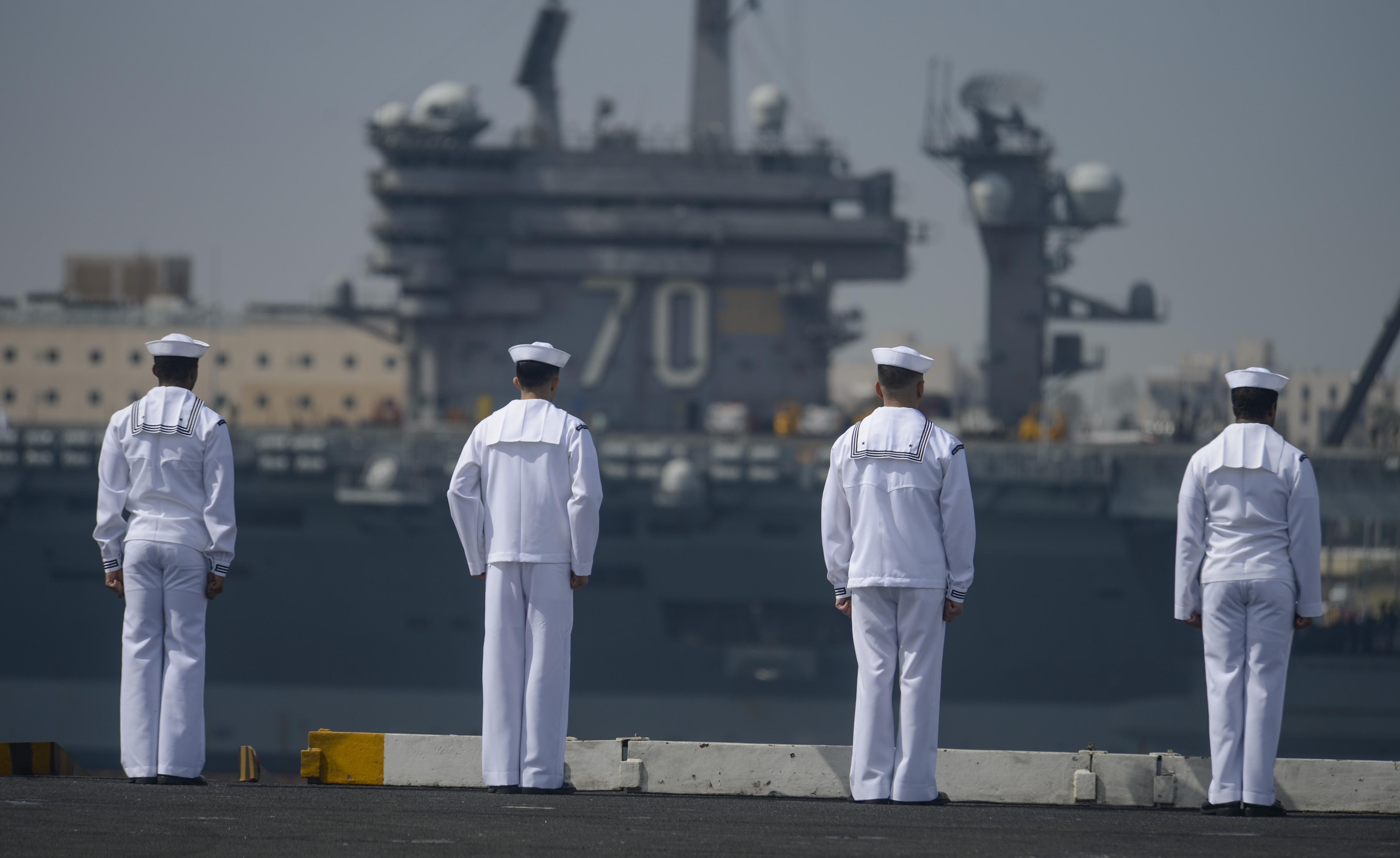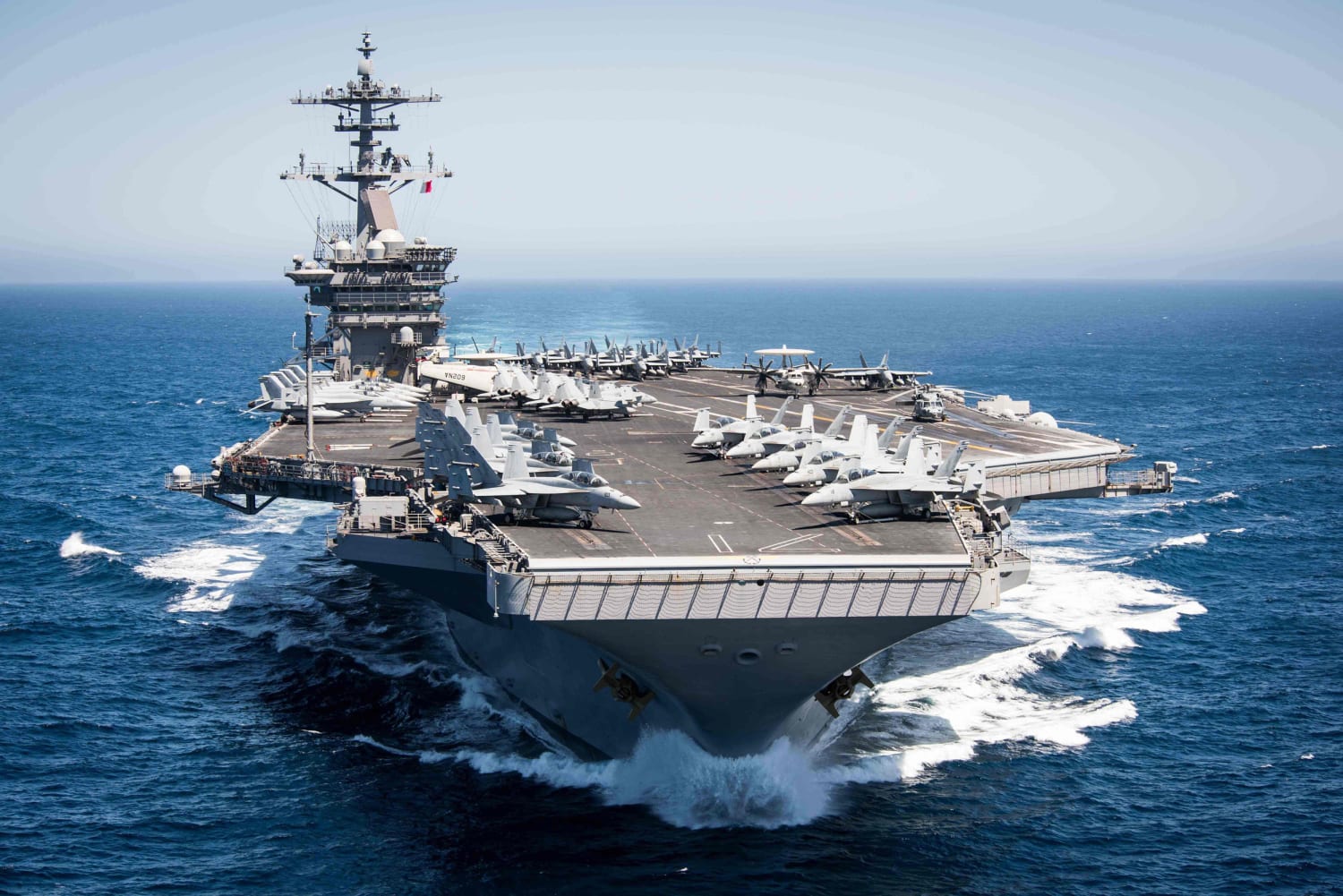Uss Theodore Rosevelt - USS Theodore Roosevelt (CVN-71) is the fourth Nimitz-class nuclear-powered aircraft carrier in the United States Navy. It was named in honor of Theodore Roosevelt, the 26th President of the United States and an advocate of naval power. She is the fourth ship named in honor of Theodore Roosevelt, three with his full name and a fourth with his last name only. Three other U.S. Navy ships have "Roosevelt" in their names in honor of members of the Roosevelt family. This carrier's radio call sign is "Rough Rider", the nickname of President Roosevelt's volunteer cavalry unit during the Spanish–American War. It was launched in 1984 and saw its first action during the Gulf War in 1991.
Initially, President Gerald Ford canceled the CVN-71 order in 1976 and replaced it with two medium, conventionally powered CVVs expected to use V/STOL aircraft. The existing T-CBL design formed the basis for the new CVV, which serves as a replacement for the obsolete Midway-class aircraft while handling all existing conventional aircraft. This ability to handle conventional aircraft proved important as the coveted V/STOL supersonic fighters were not coming to fruition at the time. In any case, the construction of the proposed medium-sized CVV carrier never took place.
Uss Theodore Rosevelt

Authorization for CVN-71 was further delayed when President Jimmy Carter vetoed the 1979 Authorization Act due to the inclusion of this Nimitz-class nuclear supercarrier in the Navy's shipbuilding program.
Uss Theodore Roosevelt Arrives In Manila > Commander, U.s. 7th Fleet > Display
Due to the Iran hostage crisis, which necessitated the increased deployment of US carrier battle groups to the Indian Ocean, President Carter reversed his stance on Nimitz-class nuclear supercarriers and the CVN-71 was subsequently authorized under the Finance Authorization Bill. year 1980 for the US Department of Defense.
Theodore Roosevelt was the first aircraft carrier to be assembled using modular construction, where large modules are built seamlessly into "layered" areas before being lifted into place and welded together. Modular construction, made possible by the use of a massive gantry crane capable of lifting 900 tons, shortened Theodore Roosevelt's construction time by 16 months, and the technique has been used on every aircraft carrier since. Theodore Roosevelt and those Nimitz-class ships completed after her have minor structural differences from the earlier aircraft carriers (USS Nimitz, USS Dwight D. Eishower, and USS Carl Vinson) and improved protection for ammunition storage in her magazines.
The story of Theodore Roosevelt began on September 30, 1980, when the contract for "Hull 624D" was awarded to Newport News Shipbuilding. Her keel was laid on 31 October 1981, while Secretary of Defense Caspar Weinberger began the first weld. On November 3, 1981, Secretary of the Navy John F. Lehman announced that the plane would be named after Theodore Roosevelt. The ship's Readiness Unit (PCU) was established in February 1984, under Captain Paul W. Parcells. On October 27, 1984, the ship was officially christened by Mrs. Barbara Lehman, wife of Secretary Lehman. On October 25, 1986, Theodore Roosevelt was assigned to active duty Newport News.
After sea trials and prep work, Theodore Roosevelt began her Maid mission on December 30, 1988 by boarding Carrier Air Wing Eight (CVW-8). The ship patrolled the Mediterranean Sea before returning on 30 June 1989. She was awarded the 1989 Battle "E" on 20 March 1990 by the Commander of the U.S. Naval Air Forces, Atlantic Fleet.
Uss Theodore Roosevelt Cvn 71 Merchandise
On December 28, 1990, Theodore Roosevelt and CVW-8 deployed to Operation Desert Shield and arrived in the Persian Gulf on January 16, 1991. With the launch of Operation Desert Storm on January 15, 1991, Theodore Roosevelt began combat operations. Ultimately flew more than 4,200 missions, more than any other airline, and dropped more than 4,800,000 pounds (2,177; 243.4 kg) of ordnance before the February 28 ceasefire.
Four US Navy aircraft carriers form 'Battle Force Zulu' after the Gulf War in 1991. Theodore Roosevelt (top right) cruises with Midway (top left), Ranger (bottom left), and America (bottom right)
When Iraqi forces turned against the Kurds, Theodore Roosevelt and CVW-8 were among the first coalition troops in Operation Provide Comfort, flying patrols over northern Iraq. After a 189-day deployment, including 176 days at sea, Theodore Roosevelt returned to Norfolk on June 28, 1991. On February 14, 1992, the ship won the second battle of "E". This was followed by the award of the Battberg Cup for 1991 as the lead ship of the Atlantic Fleet.

Theodore Roosevelt began his third deployment on March 11, 1993, again with CVW-8. A Special Purpose Marine Air-Ground Task Force (SPMAGTF) was also created, in a test of the concept of embarking a multi-role naval force in an aircraft. While the ship was still in the Cape Virginia operational area, President Bill Clinton flew into a U.S. Navy ship just hours before his first visit.
Theodore Roosevelt Carrier Strike Group Enters South China Sea > United States Navy > News Stories
Theodore Roosevelt was operating in the Adriatic Sea when CVW-8 aircraft forced Operation Dy Flight into the US no-fly zone over Bosnia. In June, on her second port visit, Theodore Roosevelt was instead ordered to cross the Suez Canal route to the Red Sea to take part in Operation Southern Watch, enforcing a no-fly zone over Iraq. Theodore Roosevelt deployed for 184 days and lasted 169 days before returning in September 1993. For the crew's accomplishments, the ship received its second Deployment Unit.
From November 1993 to April 1994, Theodore Roosevelt conducted a Selected Restricted Availability (SRA) at the Norfolk Naval Shipyard (NNSY), which was completed ahead of schedule. On March 10, 1994, Theodore Roosevelt received her third "E" strike. On June 3, Theodore Roosevelt received the second Battberg Cup as the best ship in the Atlantic fleet.
Theodore Roosevelt and CVW-8 began their fourth deployment in March 1995, operating in the Red Sea in support of Operation Southern Watch over Iraq and Operations Dy Flight and Sharp Guard in the skies over Bosnia and its operational areas in the Adriatic Sea. Dy Flight evolved into Operation Deliberate Force, when CVW-8 aircraft led NATO strikes against strategic Bosnian Serb targets in Bosnia and Herzegovina. Battle Group Theodore Roosevelt returned to Norfolk, Virginia in September 1995 and was awarded Navy Unit Command for its operations in Bosnia.
On October 14, 1996, Theodore Roosevelt collided with the USS Leyte Gulf, a Ticonderoga-class guided missile cruiser, while conducting operations off the coast of North Carolina. The incident occurred when the carrier, without prior warning, turned her knees while Leyte Gulf was behind her and collided with the cruiser's bow. No one was hurt,
Coronavirus: 60% Infected Aboard Uss Theodore Roosevelt Had Antibodies
But Theodore Roosevelt sustained over $7 million in damage to her stern, while damage to the bow of Leyte Gulf was estimated at $2 million.
Theodore Roosevelt deployed on her fifth deployment on November 25, 1996, aboard CVW-3, in support of Operation Southern Watch in the Mediterranean and Persian Gulf. The ship returned from deployment in May 1997. On July 8, 1997, Theodore Roosevelt placed Newport News Shipbuilding on a one-year Extended Drydock and Selected Restricted Availability (EDSRA), its first major overhaul since commissioning. Theodore Roosevelt returned to her homeport, Norfolk Naval Station, on July 2, 1998.
From February 1 to March 4, 1999, Theodore Roosevelt participated in Exercise JTFEX/TMDI99 along with the Brazilian Navy and several NATO navies. During the exercise, Theodore Roosevelt was submerged,

Along with eight other American ships, many of which escorted the carrier, the submarine Hr.Ms. Walrus of the Royal Navy.
Uss Theodore Roosevelt (ssbn 600)
Theodore Roosevelt began his sixth deployment on March 26, 1999 with the embarkation of CVW-8. They immediately deployed to the Ionian Sea to support NATO's Allied Force operation. Theodore Roosevelt and CVW-8 aircraft conducted airstrikes over the skies of Kosovo against Serb positions for two months. Theodore Roosevelt and CVW-8 were sent to support Operation Southern Watch, enforcing a "no-fly zone" over southern Iraq. Theodore Roosevelt returned to her home port of Norfolk, Virginia on September 24, 1999.
On January 10, 2000, Theodore Roosevelt underwent a scheduled asymmetric availability (PIA) at Norfolk Naval Shipyard, Portsmouth, Virginia for a six-month maintenance period.
After the 9/11 attacks, Theodore Roosevelt began his seventh deployment on September 19, 2001 with Carrier Air Wing One (CVW-1). On October 15, 2001, Theodore Roosevelt and CVW-1 departed the North Arabian Sea and joined the already-planned Terpriz and Carl Vinson in conducting strikes against Al Qaeda in Afghanistan for Operation Freedom.
Between departing Norfolk on 19 September 2001 and arriving in Bahrain for a freedom call on 27 February 2002, Theodore Roosevelt spent 160 consecutive days at sea, breaking the record for the longest period at sea since World War II.
Uss Theodore Roosevelt Returns To Sea Following
Theodore Roosevelt returned to port on March 27, 2002 and was awarded the Naval Unit Commdation, the 2001 Battberg Cup, and the 2001 Battle "E".
From April to October 2002, Theodore Roosevelt conducted a scheduled underavailability maintenance period at the Norfolk Naval Shipyard.
Theodore Roosevelt departed on January 6 for a planned month-long training period in the Puerto Rico area of operations. By January 12, Theodore Roosevelt received orders to cross the Atlantic to the Mediterranean. Strike Fighter Squadron 201 based at Naval Air Station Joint Reserve Base Fort Worth, Texas was ordered to act as
Theodore rosevelt quotes, theodore rosevelt national park, uss rosevelt, metal earth uss theodore roosevelt, uss theodore roosevelt cvn 71, uss theodore roosevelt website, theodore rosevelt island, uss theodore roosevelt news, uss theodore roosevelt model, uss theodore roosevelt hat, uss theodore e chandler, theodore rosevelt
0 Comments